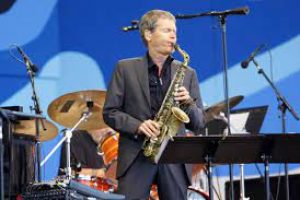David Sanborn
David Sanborn (July 30, 1945 – May 12, 2024) was an American alto saxophonist. Though Sanborn worked in many genres, his solo recordings typically blended jazz with instrumental pop and R&B. He released his first solo album Taking Off in 1975, but had been playing the saxophone since before he was in high school and was a session musician long before its release. He was active as a session musician, playing on several albums by various artists.
One of the most commercially successful American saxophonists to earn prominence since the 1980s, Sanborn was described by critic Scott Yanow as “the most influential saxophonist on pop, R&B, and crossover players of the past 20 years.” He was often identified with radio-friendly smooth jazz, but expressed a disinclination for the genre and his association with it.
Sanborn was born in Tampa, Florida, and grew up in Kirkwood, Missouri. He contracted polio in his youth. He began playing saxophone on a physician’s advice to strengthen his weakened chest muscles and improve his breathing, instead of studying piano. Alto saxophonist Hank Crawford, at the time a member of Ray Charles’s band, was an early and lasting influence on Sanborn.
Sanborn attended college at Northwestern University and studied music. But he transferred to the University of Iowa where he played and studied with saxophonist J.R. Monterose.
Sanborn performed with blues musicians Albert King and Little Milton at the age of 14. He continued playing blues when he joined The Paul Butterfield Blues Band in 1967. Sanborn recorded on four Butterfield albums as a horn section member and soloist from 1967 to 1971. In the early morning of Monday, August 18, 1969, Sanborn appeared as a member of the band at the Woodstock Music Festival at Bethel, NY. In 1972, Sanborn played on the track “Tuesday Heartbreak” on the Stevie Wonder album Talking Book. His work in 1975 with David Bowie on Young Americans and on the James Taylor recording of “How Sweet It Is (To Be Loved by You)” on the album Gorilla further brought to prominence his alto saxophone voice in popular music. In the mid-’70s, Sanborn became active in the popular jazz fusion scene by joining the Brecker Brothers band where he became influenced by Michael Brecker, and it was with the brothers that he recorded his first solo album, Taking Off, nowadays regarded as something of a jazz/funk classic. Although Sanborn was most associated with smooth jazz, he studied free jazz in his youth with saxophonists Roscoe Mitchell and Julius Hemphill. In 1993, he revisited this genre when he appeared on Tim Berne’s Diminutive Mysteries, dedicated to Hemphill. Sanborn’s album Another Hand featured avant-garde musicians. In 1985, Sanborn and Al Jarreau played two sold-out concerts at Chastain Park in Atlanta
Sanborn was a highly regarded session player from the late 1960s onwards, playing with an array of well-known artists, such as James Brown, Bryan Ferry, Michael Stanley, Eric Clapton, Bobby Charles, Cat Stevens, Roger Daltrey, Stevie Wonder, Paul Simon, Jaco Pastorius, the Brecker Brothers, Michael Franks, Kenny Loggins, Casiopea, Players Association, David Bowie, Todd Rundgren, Bruce Springsteen, Little Feat, Tommy Bolin, Bob James, James Taylor, Al Jarreau, Pure Prairie League, Kenny G, Loudon Wainwright III, George Benson, Joe Beck, Donny Hathaway, Elton John, Gil Evans, Carly Simon, Guru, Linda Ronstadt, Billy Joel, Kenny Garrett, Roger Waters, Steely Dan, Ween, the Eagles, Grateful Dead, Nena, Hikaru Utada, The Rolling Stones, Ian Hunter, and Toto.
Many of his solo recordings were collaborations with the bassist/multi-instrumentalist/composer and producer Marcus Miller, whom he met in the Saturday Night Live band in the late 1970s.
Sanborn performed with Eric Clapton on film soundtracks such as Lethal Weapon (and its sequels) and Scrooged.
In 1991, Sanborn recorded Another Hand, which the All Music Guide to Jazz described as a “return by Sanborn to his real, true love: unadorned (or only partly adorned) jazz” that “balanced the scales” against his smooth jazz material. The album, produced by Hal Willner, featured musicians from outside the smooth jazz scene, such as Charlie Haden, Jack DeJohnette, Bill Frisell, and Marc Ribot.
In 1994, Sanborn appeared in A Celebration: The Music of Pete Townshend and The Who, also known as Daltrey Sings Townshend. This was a two-night concert at Carnegie Hall produced by Roger Daltrey of English rock band The Who in celebration of his fiftieth birthday. In 1994 a CD and a VHS video were issued, and in 1998 a DVD was released. In 1995 he performed in The Wizard of Oz in Concert: Dreams Come True, a musical performance of the popular story at Lincoln Center to benefit the Children’s Defense Fund. The performance was broadcast on Turner Network Television (TNT) and issued on CD and video in 1996.
In 2006, he was featured in Gordon Goodwin’s Big Phat Band’s album The Phat Pack on the track “Play That Funky Music”, a remake of the Wild Cherry hit in a big band style. Sanborn often performed at Japan’s Blue Note venues in Nagoya, Osaka, and Tokyo. He played on the song “Your Party” on Ween’s 2007 release La Cucaracha. On April 8, 2007, Sanborn sat in with the Allman Brothers Band during their annual run at the Beacon Theatre in New York City.
In 2010, Sanborn toured primarily with a trio featuring jazz organist Joey DeFrancesco and Steve Gadd where they played the combination of blues and jazz from his album Only Everything. In 2011, Sanborn toured with keyboardist George Duke and bassist Marcus Miller as the group DMS. In 2013, Sanborn toured with keyboardist Brian Culbertson on “The Dream Tour” celebrating the 25th anniversary of the song “The Dream”.
Besides playing alto saxophone as his main instrument, Sanborn also played tenor, soprano and sopranino saxophone, saxello, flute & keyboards/piano on some recordings
Search
Expand and click on the album for more information:




